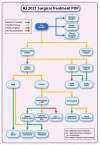Summary: 2021 International Consultation on Incontinence Evidence-Based Surgical Pathway for Pelvic Organ Prolapse
- PMID: 36294427
- PMCID: PMC9605527
- DOI: 10.3390/jcm11206106
Summary: 2021 International Consultation on Incontinence Evidence-Based Surgical Pathway for Pelvic Organ Prolapse
Abstract
(1) Background: There is wide variation in the reported prevalence rates for pelvic organ prolapse (POP). There is also wide variation in the rate at which surgical interventions for pelvic organ prolapse are performed, as well as the type of interventions undertaken. As part of the International Consultation on Incontinence (ICI), our committee was tasked to produce evidence-based pathways for the surgical management of POP, any associated stress urinary incontinence (SUI), and bowel dysfunction. (2) Methods: To enable us to generate such evidence, we undertook a thorough search for the POP surgery-related, English-language scientific literature published up to April 2021. (3) Results: The committee evaluated the literature and made recommendations based on the Oxford grading system. (4) Conclusions: This review serves to provide a summary of the 2021 ICI surgical management of an evidence-based prolapse pathway and outline the evidence used to inform this guidance.
Keywords: POP; guideline; mesh; pelvic organ prolapse; repair.
Conflict of interest statement
The authors declare no conflict of interest.
Figures
References
Publication types
LinkOut - more resources
Full Text Sources
Research Materials
Miscellaneous




